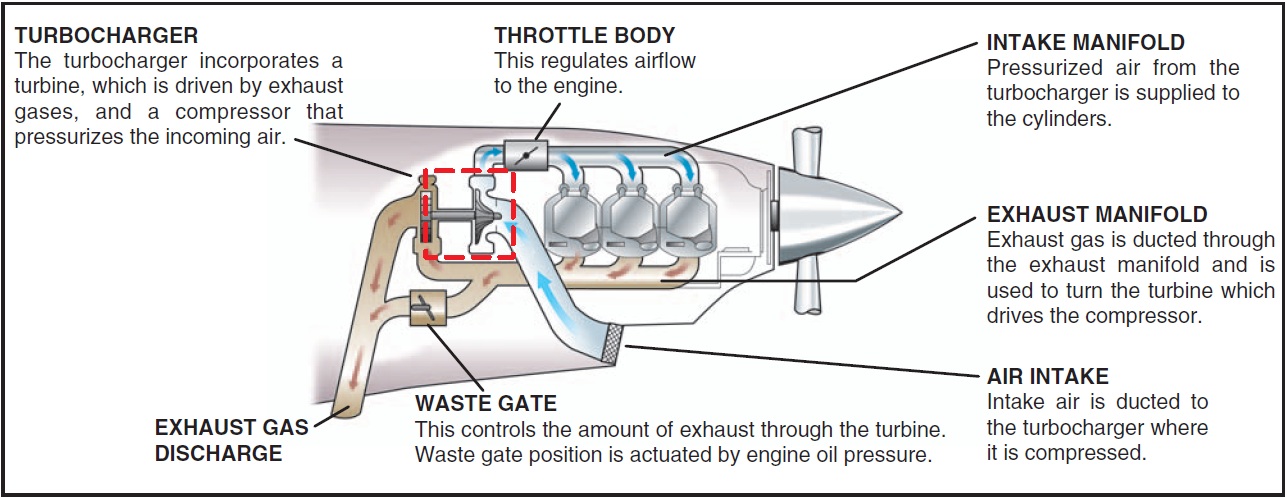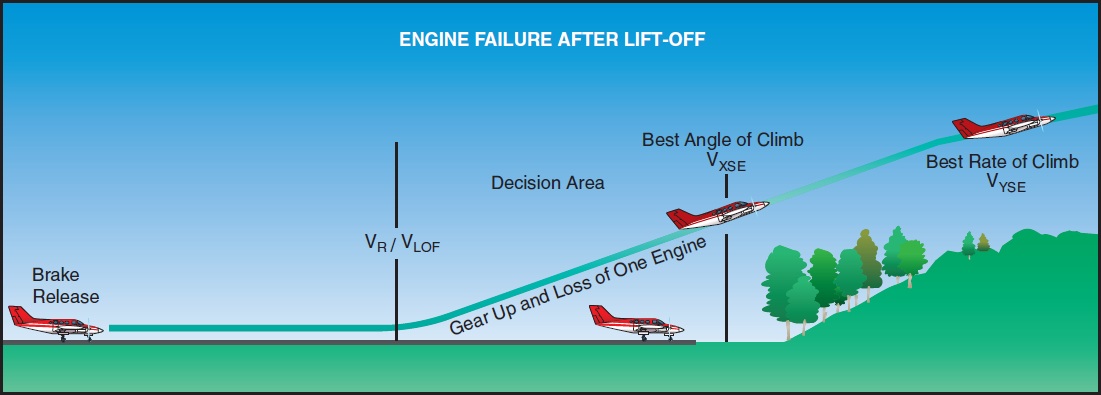
Chapter 12—Transition to Multiengine Airplanes
Table of Contents
Multiengine Flight
General
Terms and Definitions
Operation of Systems
Propellers
Propeller Synchronization
Fuel Crossfeed
Combustion Heater
Flight Director / Autopilot
Yaw Damper
Alternator / Generator
Nose Baggage Compartment
Anti-Icing / Deicing
Performance and Limitations
Weight and Balance
Ground Operation
Normal and Crosswind Takeoff and Climb
Level Off and Cruise
Normal Approach and Landing
Crosswind Approach and Landing
Short-Field Takeoff and Climb
Short-Field Approach and Landing
Go-Around
Rejected Takeoff
Engine Failure After Lift-Off
Engine Failure During Flight
Engine Inoperative Approach Landing
Engine Inoperative Flight Principles
Slow Flight
Stalls
Power-Off Stalls (Approach and Landing)
Power-On Stalls (Takeoff and Departure)
Spin Awareness
Engine Inoperative—Loss of Directional Control Demonstration
Multiengine Training Considerations

PERFORMANCE AND LIMITATIONS
Discussion of performance and limitations requires the definition of several terms.
- Accelerate-stop distance is the runway length required to accelerate to a specified speed (either VR or VLOF, as specified by the manufacturer), experience an engine failure, and bring the airplane to a complete stop.
- Accelerate-go distance is the horizontal distance required to continue the takeoff and climb to 50 feet, assuming an engine failure at VR or VLOF, as specified by the manufacturer.
- Climb gradient is a slope most frequently expressed in terms of altitude gain per 100 feet of horizontal distance, whereupon it is stated as a percentage. A 1.5 percent climb gradient is an altitude gain of one and one-half feet per 100 feet of horizontal travel. Climb gradient may also be expressed as a function of altitude gain per nautical mile, or as a ratio of the horizontal distance to the vertical distance (50:1, for example). Unlike rate of climb, climb gradient is affected by wind. Climb gradient is improved with a headwind component, and reduced with a tailwind component. [Figure 12-5]
- The all-engine service ceiling of multiengine airplanes is the highest altitude at which the airplane can maintain a steady rate of climb of 100 f.p.m. with both engines operating. The airplane has reached its absolute ceiling when climb is no longer possible.
- The single-engine service ceiling is reached when the multiengine airplane can no longer maintain a 50 f.p.m. rate of climb with one engine inoperative, and its single-engine absolute ceiling when climb is no longer possible. The takeoff in a multiengine airplane should be
- planned in sufficient detail so that the appropriate action is taken in the event of an engine failure. The pilot should be thoroughly familiar with the airplane’s performance capabilities and limitations in order to make an informed takeoff decision as part of the preflight
- planning. That decision should be reviewed as the last item of the “before takeoff” checklist.

Figure 12-5. Accelerate-stop distance, accelerate-go distance, and climb gradient.
In the event of an engine failure shortly after takeoff, the decision is basically one of continuing flight or landing, even off-airport. If single-engine climb performance is adequate for continued flight, and the airplane has been promptly and correctly configured, the climb after takeoff may be continued. If single-engine climb performance is such that climb is unlikely or impossible, a landing will have to be made in the most suitable area. To be avoided above all is attempting to continue flight when it is not within the airplane’s performance capability to do so. [Figure 12-6]

Figure 12-6. Area of decision.
Takeoff planning factors include weight and balance, airplane performance (both single and multiengine), runway length, slope and contamination, terrain and obstacles in the area, weather conditions, and pilot proficiency. Most multiengine airplanes have AFM/POH performance charts and the pilot should be highly proficient in their use. Prior to takeoff, the multiengine pilot should ensure that the weight and balance limitations have been observed, the runway length is adequate, the normal flightpath will clear obstacles and terrain, and that a definitive course of action has been planned in the event of an engine failure.
12-8
Ch 12.qxd 5/7/04 9:54 AM Page 12-9
The regulations do not specifically require that the runway length be equal to or greater than the accelerate- stop distance. Most AFM/POHs publish accelerate-stop distances only as an advisory. It becomes a limitation only when published in the limitations section of the AFM/POH. Experienced multiengine pilots, however, recognize the safety margin of runway lengths in excess of the bare minimum required for normal takeoff. They will insist on runway lengths of at least accelerate-stop distance as a matter of safety and good operating practice.
Ch 12.qxd 5/7/04 9:54 AM Page 12-10
The multiengine pilot must keep in mind that the accelerate-go distance, as long as it is, has only brought the airplane, under ideal circumstances, to a point a mere 50 feet above the takeoff elevation. To achieve even this meager climb, the pilot had to instantaneously recognize and react to an unanticipated engine failure, retract the landing gear, identify and feather the correct engine, all the while maintaining precise airspeed control and bank angle as the airspeed is nursed to VYSE. Assuming flawless airmanship thus far, the airplane has now arrived at a point little more than one wingspan above the terrain, assuming it was absolutely level and without obstructions.
With (for the purpose of illustration) a net 150 f.p.m. rate of climb at a 90-knot VYSE, it will take approximately 3 minutes to climb an additional 450 feet to reach 500 feet AGL. In doing so, the airplane will have traveled an additional 5 nautical miles beyond the original accelerate-go distance, with a climb gradient of about 1.6 percent. A turn of any consequence, such as to return to the airport, will seriously degrade the already marginal climb performance.
Not all multiengine airplanes have published accelerate- go distances in their AFM/POH, and fewer still publish climb gradients. When such information is published, the figures will have been determined under ideal flight testing conditions. It is unlikely that this performance will be duplicated in service conditions.
The point of the foregoing is to illustrate the marginal climb performance of a multiengine airplane that suffers an engine failure shortly after takeoff, even under ideal conditions. The prudent multiengine pilot should pick a point in the takeoff and climb sequence in advance. If an engine fails before this point, the takeoff should be rejected, even if airborne, for a landing on whatever runway or surface lies essentially ahead. If an engine fails after this point, the pilot should promptly execute the appropriate engine failure procedure and continue the climb, assuming the performance capability exists. As a general recommendation, if the landing gear has not been selected up, the takeoff should be rejected, even if airborne.
As a practical matter for planning purposes, the option of continuing the takeoff probably does not exist unless the published single-engine rate-of-climb performance is at least 100 to 200 f.p.m. Thermal turbulence, wind gusts, engine and propeller wear, or poor technique in airspeed, bank angle, and rudder control can easily negate even a 200 f.p.m. rate of climb.
PED Publication